#pharaoh Thutmose IV
Text
The Dream Stele: An Epigraphic Stele of Divine Kingship and Historical Intrigue in Ancient Egypt
The Dream Stele, also known as the Sphinx Stele, holds a significant place in ancient Egyptian history, particularly during the reign of the 18th Dynasty pharaoh Thutmose IV. Erected in 1401 BC, it stands as a remarkable example of an epigraphic stele, symbolizing the divine legitimization of kingship, a common practice among the rulers of the New Kingdom era.
Crafted from granite, the Dream…

View On WordPress
#African History#ancient Egyptian#Ancient Egyptians#ancient egyptians history#Dream Stele#Great Sphinx of Giza#New Kingdom#pharaoh Thutmose IV#Sphinx Stele#Tanetjerians
1 note
·
View note
Photo
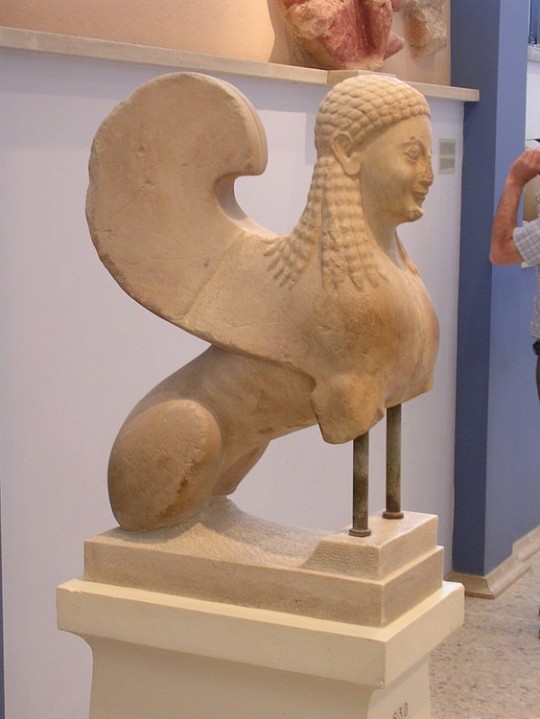
Sphinx
A Sphinx is a mythical creature with the body of a lion, most often with a human head and sometimes with wings. The creature was an Egyptian invention and had a male head - human or animal; however, in Greek mythology, the creature had the head of a woman. The sphinx is also present in the art and sculpture of the Mycenaean, Assyrian, Persian and Phoenician civilizations.
Egyptian Sphinxes
Sphinxes were first created by the Egyptians and usually wore a nemes (head-dress) as worn by Pharaohs. Examples exist of sphinxes with human faces but surrounded by a lion's mane, particularly from Nubia, and in the New Kingdom the head was sometimes that of a ram and representative of Amun. The exact date when the first sphinx appeared is not known and the most famous sphinx of all, the Great Sphinx of Giza, has not been precisely dated; some scholars date it as far back as the reign of Cheops, ca 2500 BCE. There is a story that in the Eighteenth Dynasty, Pharaoh Thutmose IV, when he was a mere prince, went on a hunting expedition and fell asleep in the shadow of the Sphinx. Whilst asleep he dreamt that the Sphinx spoke to him and promised that he would become king if he cleared the sands that had accumulated around the feet of the statue. In the reign of Chephren, sphinxes became more widespread and they were usually placed as guards outside or beside a mortuary temple, tomb or funerary monument.
Continue reading...
52 notes
·
View notes
Text

This is Maiherperi, he was an ancient Egyptian noble of Nubian origin buried in tomb KV36 in the Valley of the Kings. He probably lived during the rule of Thutmose IV (1401- 1391 or 1397- 1388 BC) , and received the honour of a burial in the royal necropolis. His name can be translated as Lion of the Battlefield.
Amongst his titles were Child of the Nursery and Fan-bearer on the Right Side of the King. There is speculation that the first title signified that he grew up in the royal nursery as a prince of a vassal territory, or perhaps was the son of a lesser wife or concubine of the pharaoh.
Via reddit
150 notes
·
View notes
Text
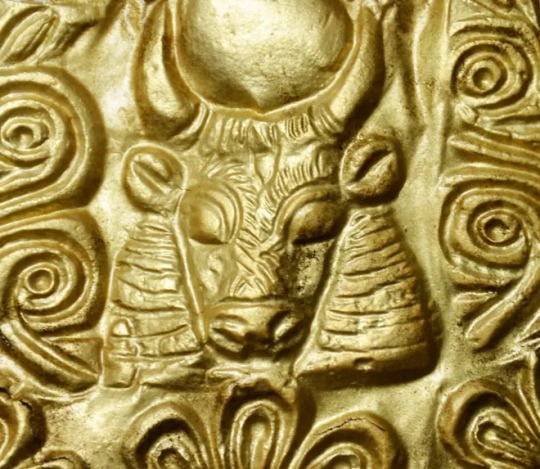
Tombs Rich in Artifacts Discovered in Cyprus
An archaeological expedition from Sweden's University of Gothenburg has uncovered tombs rich in artifacts and antiquities in Cyprus that makes the discovery among the richest ever found in the Mediterranean region.
Peter Fischer, the leader of the expedition and a professor of archaeology at the University of Gothenburg, said “considering the richness of the grave goods, it is a reasonable assumption that these were royal tombs, even though we do not know much about the form of government practiced in the city at the time."
Fischer believes that the artifacts, found just outside the Bronze Age trading city of Hala Sultan Tekke, indicate the tombs' occupants ruled the city, which was a center for copper trade between 1500–1300 BCE. The tombs, located outside the 50-hectare city, consist of underground chambers of varying sizes, accessed via a narrow passage from the surface.
Cyprus' Department of Antiquities, in an update posted to their website, noted: "The city’s wealth seems to have been based on the production of copper and trade with near and distant cultures. Judging by the rich burial gifts, the tombs belonged to families of the city’s ruling class who took part in the export of copper and intercultural trade."
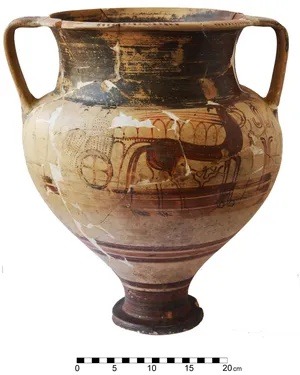
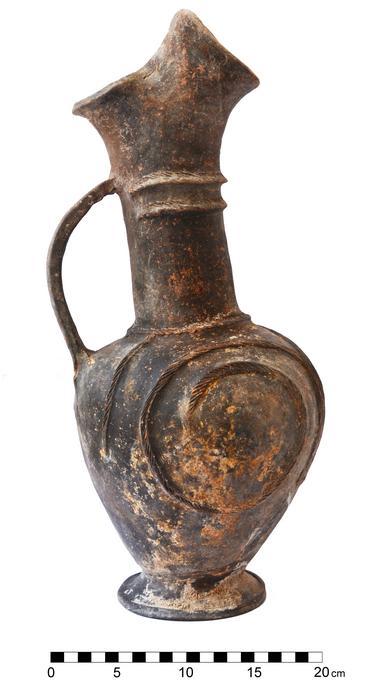
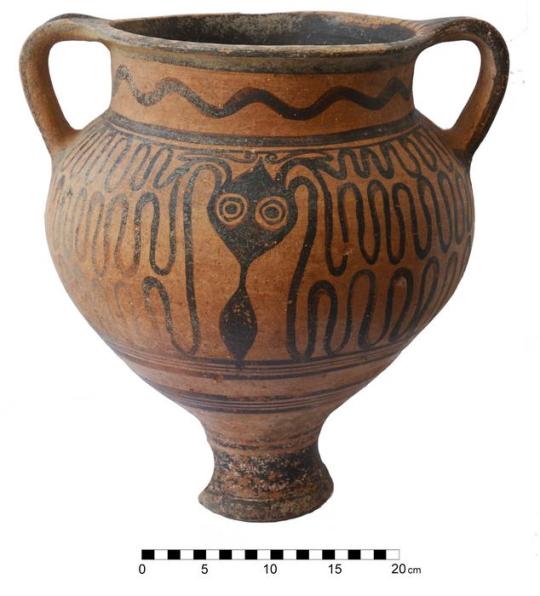
Unearthed artifacts include imports from Egypt, Baltic region
The Swedish Söderberg expedition has been carrying out excavations in Hala Sultan Tekke near the city of Larnaca on the south coast of Cyprus since 2010. Though the expedition has previously found chamber tombs with valuable grave goods, the latest discovery is unprecedented given the superb quality and quantity of artifacts.
“We found more than 500 complete artifacts distributed among two tombs. Many of the artifacts consist of precious metals, gems, ivory and high-quality ceramics," Fischer said.
About half of the artifacts unearthed during the expedition are believed to have been imported from different civilizations. For example, gold and ivory came from Egypt while precious stones, such as blue lapis lazuli, dark red carnelian and blue-green turquoise, were imported from Afghanistan, India and Sinai respectively. Amber objects from the Baltic region were also found among the artifacts.
The Department of Antiquities said that three chamber tombs, preliminarily dated to the 14th century BC, were exposed. While one of them had been looted, most likely in the 19th century AD, the other two were "undisturbed", apart from the collapse of their chambers.
Items recovered from those include locally produced pottery and ornaments and numerous items of jewelry such as diadems, which are ornamental headbands. Embossed images of bulls, gazelles, lions and flowers adorn the diadems. Bronze weapons, some inlaid with ivory, were also recovered as well as a gold-framed seal made of the hard mineral hematite with inscriptions of gods and rulers.
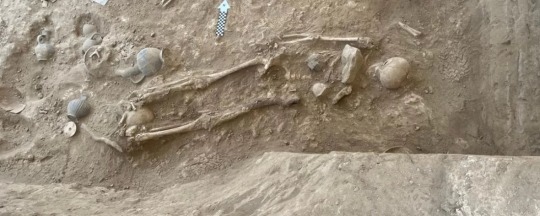
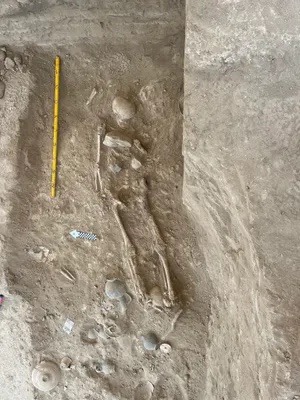
"Several items of ivory and faience are imports from Egypt during the famous 18th Dynasty, the time of the well-known pharaohs Thutmose III, Amenophis IV (Akhenaten) and his wife Nefertiti," said the department.
The excavation team used magnetometers, a type of instrument that can produce images showing objects and structures up to two meters beneath the surface, to carry out their expedition, according to the university.
Besides artifacts, the research team also unearthed several well-preserved skeletons in the tombs including one of a woman surrounded by dozens of ceramic vessels, jewelry and a round bronze mirror. A one-year-old child with a ceramic toy also lay beside her.
By Saman Shafiq.
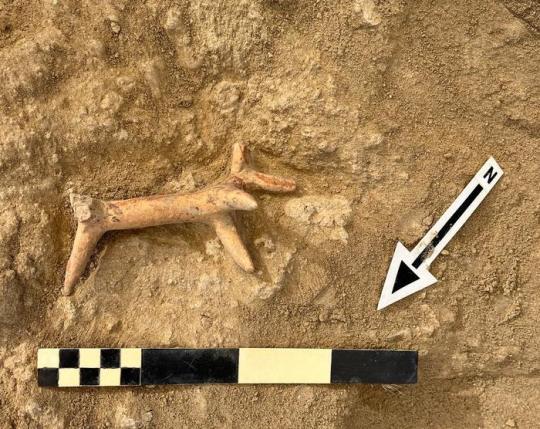
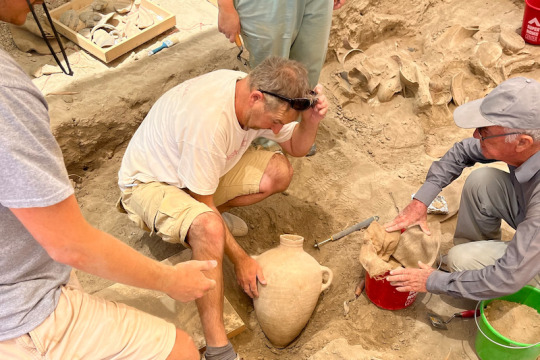
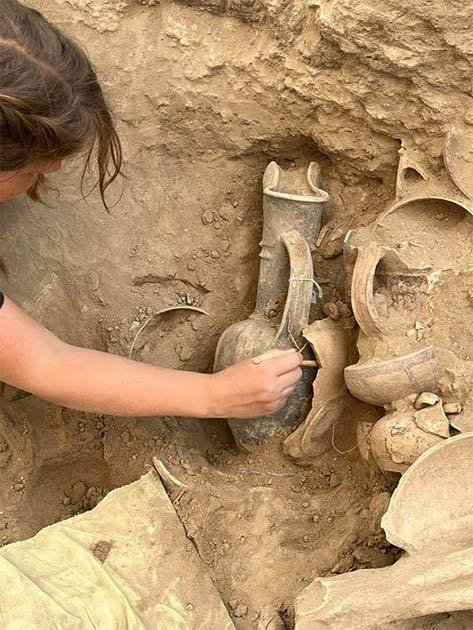
#Tombs Rich in Artifacts Discovered in Cyprus#Bronze Age city of Hala Sultan Tekke#ancient tomb#chamber tombs#ancient graves#ancient artifacts#archeology#archeolgst#history#history news#ancient history#ancient culture#ancient civilizations
40 notes
·
View notes
Text

Ivory bracer of the 18th Dynasty pharaoh Thutmose IV. Thutmose is shown subduing an Asiatic enemy while a falcon-headed deity looks on. Artist unknown; 1397-1388 BCE. Found at Amarna*; now in the Neues Museum, Berlin. Photo credit: Osama Shukir Muhammed Amin FRCP/Wikimedia Commons.
*It is unknown how the bracer ended up at Akhenaten's capital.
#art#art history#ancient art#Egypt#Ancient Egypt#Egyptian art#Ancient Egyptian art#Egyptian religion#Ancient Egyptian religion#kemetic#Thutmose IV#18th Dynasty#New Kingdom#jewelry#jewellery#bracer#ivory#carving#Amarna#Neues Museum
110 notes
·
View notes
Text
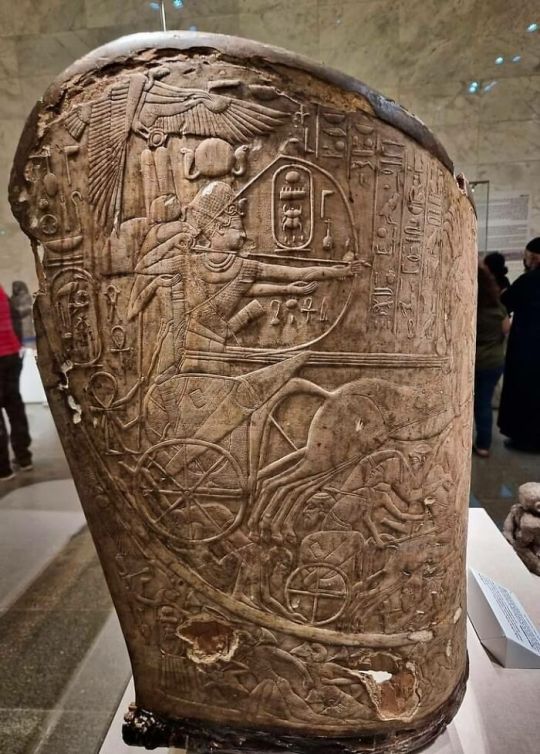
#بلادي_الجميلة ❤ #مصر ❤ The Well Preserved State Chariot Of Pharaoh Thutmose Iv (R. 1401-1388 Bc, 18th Dynasty), Showing Pharaoh Smiting His Enemies. It Was Discovered From His Tomb Kv43, Luxor, Egypt , Museum Of Egyptian Civilization, Cairo
#egypt#مصر#ancient egypt#مصريات#love#war#wars#war chariot#chariot#egyptian#Egyptian civilization#civilization#art#ancient#ancient art#ancientmonuments#ancient history#history#dynasty#thutmose#18th dynasty#life#بلادي الجميلة#museum#ancient architecture#protection#enemy#enemies#artifact#ancient artifacts
19 notes
·
View notes
Text

Chariot of Pharaoh Thutmose IV (r. 1401-1388 BC, 18th dynasty)
5 notes
·
View notes
Text
Women’s History
viking age (800 to 1050 AD)
most women in the viking age were housewives to their husbands. they often managed the farms and agricultural responsibilities. women were believed to have a choice on who their husband was to be, and even were thought to be able to back out of a marriage if they later decided they didn’t like their husband.
women spent much of their time in the house working with wool, spinning yarn, sewing, and weaving for her family. taking care of the children was a large part of a woman’s life in the viking age. women were expected to have many children to help around the house, and they were expected to breastfeed each child after they were born (since formula was yet to exist).
compared to many women during this time period, viking women had lots of freedoms. in mythology the women are portrayed as independent, confident, and powerful. however, women at this time could not appear in court or receive a share of the man’s inheritance. men had all the political power in this society. literature from this time also shows that women could often find themselves with power if they could somehow make their husband respect them.
ancient egypt (2700 to 1100 BCE)
we all know the famed cleopatra, but ancient egypt has a longer history of powerful women. one of the first female pharaohs in egypt was hatshepsut, who began her rule around 1500 BCE. hatshepsut became queen when she married thutmose ii (her half-brother), around the age of 12. upon thutmose’s death in 1479 BC, she became regent for her stepson, who at the time was an infant. seven years later, she took on the title and full powers of a pharaoh, co-ruling with her stepson. hatshepsut’s step to power garnered lots of controversy, and she had to fight to prove her legitimacy to the throne. she was born to thutmose i, and she claimed that he had appointed her his successor. hatshepsut ordered to be portrayed as a male once she claimed the throne, wanting to be depicted with a beard and a muscular body. despite this order, there are images where she appears in the traditional female regalia of ancient egypt. she tried to surround herself with supporters from key positions in the ancient government, likely hoping to elevate her status and the trust of her subjects. she began taking on ambitious projects during the time of her rule. she is notably known for the memorial temple at deir el-bahir. she also authorized a trading expedition that brought back many profits for egypt like ivory, ebony, gold, leopard skins, incense, and more. hatshephut died around 1458 BC (in her mid-40s) and was buried in the valley of the kings located in the hills of deir el-bahir. her father was reburied to be with her, in a last effort to legimitize her reign. thutmose iii had almost any trace of hatshephut erased upon his rule, so she was not known about by scholars until 1822. another female ruler of egypt was nefertiti. she married amenhotep iv. it’s unknown exactly who nefertiti’s parents were, although it’s theorized she is either the daughter of ay, or a princess from a mittani kingdom in northern syria. amenhotep iv was a monotheist, and during his reign he displaced egypt’s cheif god, amon, in favor of aten. he also changed his name to akhenten, and nefertiti took the additional name of “neferneferuaten” which means “beautiful are the beauties of aten, a beautiful woman has come”. under her husband’s rule she began to be depicted as a mirror image of him. in tombs and temples built during akhenten’s reign, nefertiti is depicted in positions of power and authority that no other queen had been seen depicted with. some instances of this were leading worship of aten, or even smiting enemies. nefertiti mothered six daughters, and after the sixth, akhenten took other wives to eventually birth king tutankhamen. king tut would eventually go on to marry nefertiti’s daughter ankhesenpaatan. around the 12th year of akhenten’s reign, nefertiti seems to disappear from record. it is possible that this is because of her death, although many historians and scholars theorize that she actually took the guise of a man to rule alongside her husband as smenkhkare. it is thought that after his death, she took place to begin undoing his religious policies, which is rooted in the fact that nefertiti paid for a scribe to make divine offerings to amun, begging and pleading with the high god to come back and get rid of the darkness in her kingdom.
the most well known of the female rulers in ancient egypt is cleopatra. she was born in either 70 or 69 BC, the first daughter of ptolemy xii. at age 18, Cleopatra became the dominant co-regent with her 10 year old brother, ptolemy xiii. her brother’s advisors quickly took action against her place on the throne, and cleopatra fled egypt to syria in 49 BC. there, she raised an army, and returned to egypt to create a civil war at pelusium. during this time, ptolemy invited julius caesar to alexandria. cleopatra allegedly snuck into royal palace to plead for caesar’s help. caesar needed for egypt to pay it’s debts owed to auletes in order to fund his own return to power in rome. many months of fighting between the forces of julius caesar and ptolemy xiii occurred until roman reinforcements showed up and the pharaoh was forced to flee alexandria. thought of have drowned in the nile river, ptolemy xiii was never seen again. caesar entered alexandria and restored cleopatra to power, where she became co-regent to another younger brother of hers, ptolemy xiv (13 at the time). julius caesar stayed with cleopatra in egypt, and in 47 BC they had a child, ptolemy caesar, who was known to the egyptian people as “little caesar”. around 46 BC cleopatra traveled with her brother and son to visit caesar in rome, as he had returned sometime before. after he was murdered in 44 BC, she returned to egypt. ptolemy xiv was murdered soon after. cleopatra was named co-regent to her son. her hold on power at this time was as much as she had ever had, being that her son was still an infant. flooding began to lead to inflation and hunger while egypt was being asked for help in a roman conflict. cleopatra sent four roman legions who caesar had stationed in egypt to help his previous allies in rome. in 42 BC, after defeating caesar’s assassins, his allies split power in rome. mark antony, one of the allies, summoned cleopatra to tarsus to explain the role she had played in the roman conflict. according to plutarch, mark antony was seduced by cleopatra and agreed to protect egypt, along with cleopatra’s crown. cleopatra returned to egypt, followed by antony. he spent two years in alexandria. in this time, him and cleopatra formed a drinking society called “the inimitable livers”. in 40 BC, after antony had returned to rome, cleopatra gave birth to a set of twins who she donned alexander helios and cleopatra selene.
commonfolk women in egypt had a duty first as a mother and wife, often having professions like weaving, perfume making, and entertainment. despite their first commitment being towards family, they were allowed to have their own businesses, own and sell property, and serve as witnesses in a court case. many women in the middle east at the time were not allowed to be in the company of men, but in egypt they could be. divorce was also an option for the women of egypt as they were allowed to use it in order to escape bad marriages. from our earliest records, women and men seem to have a fairly similar formal status. both men and women in ancient egypt were able to choose their actions, and had to suffer the consequences of their own actions. women were legally allowed to acquire, own, and sell property, with or without a husband. they were allowed to initiate court cases, as well as do many other legal proceedings under their own name, rather than that of their husband. from the evidence we’ve recovered from the old kingdom, women were often shown as merchants and priestesses (most commonly being priestess for hathor).
although these may not seem like incredible privileges, ancient egypt was well ahead of other societies at the time and their views on equality.
ancient greece
women in ancient greece had very little rights under their own name. they were unable to vote, own/inherit land, and were often only seen as mothers and wives. women were allowed to go to school, but often had more of an emphasis towards dancing and music than towards academic subjects. women in ancient greece were expected to be virgins upon marriage, and were meant to marry at a young age. in most cases, the marriages were organized by the father, often having him sign a dowry for his daughter to marry someone’s son. if they did not have a father another male guardian or relative must sign off on the marriage. married off at 13 or 14, women lived their lives at home, their husbands often seeking satisfaction outside of their marriages. there was no a place in society for single females, as roles for them did not exist.
married women in ancient greece were seen as the property of their husbands by the law. they were expected to be faithful, despite their husbands having the option of going off to prostitutes, and were expected to bear children of the men they (most often) didn’t truly love. they were seen as incapable of making decisions for themselves. if a wife were to not honor her family, she would be banned from religious ceremonies, which in this society was an incredibly huge dishonor. if she were to cheat on her husband, the husband could kill her with no legal prosecution taking place. women had few personal belongings, most of which were clothes and jewelry that had been given to them. if one’s husband were to die, they could not inherit anything from the will, instead having to remarry and let her new husband claim it. if a father were to die, they’d leave their legacy for their male children, and if the women were an only child, her husband would be the one to claim the inheritance.
despite the treatment of women in ancient greek society, there were many powerful goddesses in greek mythology. athena was attributed goddess of wisdom and military victory, aphrodite the goddess of love and beauty, demeter the goddess of agriculture, hera the patron of childbirth, artemis the goddess of the hunt, selene the goddess of the moon, so on, and so on. women in the mythology are often depicted as emotional and troublemakers, showing their view on women during the time.
middle ages (5th to late 15th century)
women during the middle ages often had jobs working the land, and they participated in agricultural duties alongside men. women in the lower class were often bakers, brewers, milkmaids, barmaids, artisans, weavers, and farmers.
women of the time could be educated, but most were only educated in domestic affairs like sewing and cooking. although, noblewomen and nuns had access to many books, the common population did not. education was mostly restricted to the upper class and the clergy. women could have a place in the clergy, but only as nuns. noblewomen had power depending on how much land they brought to their marriage, as during this time, land often equaled power. women were expected to remain “pure” until they found themselves a husband.
women in the early middle ages found themselves gaining power for multiple reasons. with the outbreak of the black death, many of the european population died. because of the lack of people, women were allowed to own businesses that belonged to their late husbands. they were also gaining rights due to the popularity of the cult of the virgin mary. despite gaining a few rights within this time, they were always viewed as second class citizens, their lives an afterthought to the men who ruled.
marriage rights in this time were decided by the lords. once a woman was married, her husband was considered to be her owner. he would control what his wife’s interests and were considered responsible for any behavior a woman may show.
the reason women had so few rights during this time was because of the rise of the catholic church, and their beliefs lying in the story of adam and eve, seeing women as temptresses and often finding them to be evil.
women’s suffrage
during the 1820s and 1830s, the campaign for women’s suffrage truly begins. reform groups were beginning to organize across the united states, and women played a prominent role in the movements. in 1848, a group of abolitionist-activists gathered in seneca falls to discuss women’s rights. the majority of the group agreed that women were their own individuals that should have their own political identities.
when the 14th and 15th amendments were introduced, the women’s suffrage movement pushed for women’s rights to be introduced. the 14th amendment that allowed black men to vote defined citizens as males. women pushed harder against lawmakers to no avail. many women began to ally with racist southerners in an attempt to prevent the 15th amendment.
in 1869, the national women’s suffrage administration was founded by elizabeth cady stanton and susan b. anthony. the endangerment towards the rights of people of color by tying the movements together resulted in the formation of the american woman suffrage association. this group fought state-by-state for the enfranchisement of women, while also supporting the 15th amendment.
in 1890, the groups merged together to become the national american woman suffrage association. this group used a new argument for women’s suffrage. previously, women were arguing for the right to vote since they were equal to men, but in 1890 women began arguing for the right to vote because they were different from men. this argument served to the advantage of the women as it addressed many political agendas.
in 1910, western states began granting women the right to vote. southern and eastern states resisted this change, not believing women were worthy of the same rights as men. in 1916, the president of the national women’s suffrage association revealed the “winning plan”. this plan was a campaign which had local and state suffrage organizations travel the country to fight for their rights.
at the same time, the national women’s party was founded by alice paul. their strategy was to create drama such as hunger strikes and protests in front of the white house.
the mission of the suffragettes was slowed due to world war one. women managed to spin the narrative in their favor, claiming that their efforts during the war showed they were just as deserving as men of the right to vote, and on august 20, 1920, the 19th amendment was ratified.
some of my favorite women throughout history
marie-antoinette-josèphe-jeanne d’autriche-lorraine (originally maria antonia joseph’s joanna von österich-lothringen) was born november 2, 1755 in vienna, austria. she was the 11th daughter of the holy roman emperor francis i and maria theresa. at 14 years old, marie-antoinette’s hand in marriage was given to heir to the throne, louis xvi. she had an unpopular image when relations between france and austria became rocky. the public viewed her to be a representative of austria, which was a view that stuck to her her entire life. louis was an incredibly inattentive husband to the young girl, so she sought out entertainment in a circle of favorites and politically vulnerable companions. marie-thérèse-louise de savoie-carignan was one of marie-antoinette’s closest friends during this time. marie had very little political duties and spent lots of time indulging in her well-known extravagant taste. many people in the public poked fun at her at the time, and began to spread outlandish and sexual rumors about the girl. it became a trend to blame all of france’s problems on marie-antoinette.
after the american revolution, france began to fall into debt, and although it wasn’t her fault, marie began to get lots of blame. as time went on, many people began labeling her an “austrian whore”.
in oct of 1789, a min of parisian women protesting dragged the entire royal family to the city and imprisoned them. in june of 1781, louis xvi and marie-antoinette fled paris, hoping to escape to austria. there was a rumor that the holy roman emperor had troops prepared to invade france. this rumor once again sparked controversy for marie, labeling her as a traitor.
the royal family returned to france ans louis was reinstated as king. in april of 1792, the radical revolutionary government declared war against austria. the french army, which was broken in pieces at this point, did not fair well. they turned their blame to marie once again. in august, a mob overthrew the monarchy and locked the royal family in tower. the next month, revolutionaries began to massacre royalist prisoners by the thousands. during this time, marie’s best friend, princesse de lamballe, was dismembered in the streets. her body parts were then paraded through paris.
in december, louis was put to trial and beheaded for treason. in july of 1793, marie lost custody of her son, who was then forced to accuse her of sexual assault and incest against him. she was sent to the guillotine for treason at age 37.
-
anne boleyn was born around 1500 to sir thomas boleyn and elizabeth howard. much of childhood was spent in hever castle in kent, as her mother was the daughter of one of the most powerful men in the country.
in 1513, anne was sent to the court of marageret of austria, later being moved to a french court. anne had originally served as a companion to louis xii’s wife, mary. after his death in 1515, she settled in france in the household of queen claude. anne stood out amongst these courts as she was talented in music and dance. in 1522, boleyn returned to england and resides in king henry viii’s court. many people admired her beauty and youth, including the king himself.
at the time, henry was married to catherine of aragon, and together they had a daughter named mary. in 1527, henry began to secretly plan an annulment for his wedding to queen catherine. the pope refused to grant the annulment to henry.
in january of 1533, henry and anne were secretly wed. on easter of that year, their wedding was made public. their marriage was only valid due to the fact that henry changed the church that england followed with. while married to catherine of aragon, england followed the rules and regulations of the catholic church, but upon his marriage with anne, the country found itself operating under the church of england.
anne bore a child, elizabeth i. unfortunately, after this, she had many miscarriages followed but no successful pregnancies. in 1536, anne was accused of adultery and plotting against the kings life. on may 2, she was arrested and taken to the tower of london. anne tried to plead innocent, but the king had already fallen for another mistress and took no mercy upon her pleas. on may 19, she was beheaded by a skilled swordsman. her final words were reported to have been, “i am come hither to die, for according to the law and by the law i am judged to die, and therefore i will speak nothing against it… i pray god save the king… for a gentler nor a more merciful prince was never there.” she was buried in the chapel of st. peter and vincula tower.
11 days after anne’s execution, henry married his mistress, jane seymour.
-
marie laveau was born september 10, 1801. she is often referred to as the most famous voodoo queen of the south. while there isn’t much information available about marie laveau, many scholars agree the story begins with her grandmother, catherine henry. catherine was said to have gone through a long line of owners before being emancipated and becoming a free woman of color. catherine took the name and surname of her first master henry roche belaire. catherine’s daughter, marguerite remained with roche until he died before being sold to another. this new master set her free.
after having gained her freedom, marguerite became a placée of henri d’arcantel. a placée performed all the duties of a wife, but were not recognized as such to the public.
marie’s father, charles laveau, was a free black man, so when marie was born, she found herself born into freedom. there is little known about marie’s childhood, but it’s believed that she lived with her grandmother.
legal records show a marriage contract between marie and jacques paris. they married on august 4, 1819. it is debated on whether or not they had children.
marie was known as the “widow paris”, although it’s unknown what happened to her husband. she became a hairdresser following his death, catering specifically to wealthy and white families. she began a relationship louis christophe dominic duminy de glapion, they were together until his death in 1885. there are no records she was in any more relationships after his death. there’s official documentation of seven children from this marriage, although some believe she may have had fourteen or fifteen.
sometime in the 1820s marie was known to have started a career in voodoo. she was known to have given private sessions and sell invocations, as well as magickal objects. later in life, she was known to visit church and do charitable acts, although many scholars believe laveau was a catholic her entire life. in her final years, she spent time with her family and continued her charity.
-
sources
https://www.ushistory.org/civ/3f.asp#:~:text=Egyptian%20women%20could%20have%20their,marriages%20by%20divorcing%20and%20remarrying.
https://fathom.lib.uchicago.edu/1/777777190170/
https://www.worldhistory.org/article/927/women-in-ancient-greece/
https://www.getty.edu/news/what-was-life-like-for-women-in-the-middle-ages/\
https://www.worldhistory.org/article/1345/women-in-the-middle-ages/
https://sites.udel.edu/britlitwiki/women-in-medieval-literature-and-society/
https://www.history.com/.amp/topics/womens-history/the-fight-for-womens-suffrage
https://www.history.com/news/9-things-you-may-not-know-about-marie-antoinette
https://www.britannica.com/topic/woman-suffrage
https://www.britannica.com/biography/Marie-Antoinette-queen-of-France
https://www.hrp.org.uk/tower-of-london/history-and-stories/anne-boleyn/#gs.trtum7
https://www.britannica.com/biography/Anne-Boleyn
https://louisiana-anthology.org/encyclopedia/l/whitaker--laveau.html
https://www.womenhistoryblog.com/2012/07/marie-laveau.html
#women#international women's day#women history#women's suffrage#women's rights#viking women#greek women#Middle Ages women#marie antoinette#marie laveau#anne boleyn#misunderstood women
11 notes
·
View notes
Text
History of Egyptian Statues in Divination
How to Seek a Prediction
Seek out a priest, or wait for one to arrive, likely by boat
Equipment
Special statue, possibly with movable head for “nodding”
Personnel
Priest trained in decreeing oracles
Description
Oracles appear relatively late in the long span of Egyptian history
The first representations of a sacred boat containing an oracular statue of the god Amun date to the early New Kingdom (reign of Amenhotep I, around 1525 BCE)
While there are some earlier textual references, neither the Old Kingdom (Pyramid Age, around 2686-2181 BCE), nor the Middle Kingdom (age of great Egyptian literature, around 2055, 1650 BCE), seem to place much reliance on decrees from oracles
It is the New Kingdom, and the following Third Intermediate Period (about 1069-664 BCE) and Late Period (about 664-332 BCE) where we find the most frequent mention of oracular decisions, both royal and “private”
There was no singular god responsible for all oracular decrees
The Egyptians appealed to many forms of the god Amun, Amun-Re, and other deities, state and local; even the defied king Amenhotep I was consulted by many resident of Thebes
Throughout Egyptian history we see an ebb-and-flow in perceptions of the divine nature of the pharaoh
At times the populace relied upon the king and the pharaonic court system, at other times direct appeals to the gods for assistance were far more common
Methods included approaching the statue of the god, borne in his sacred bark upon the shoulders of priests, during festival processions
Or, people could submit “yay or nay” inscriptions to the deity for a definitive decision; the bark or statue would walk forwards (yes) or backwards (no)
Some scholars believe that “nodding” indicated that certain statues had moving parts, manipulated by the priests, making this a potentially very human-influenced divination system
As far as selecting the next pharaoh was concerned, both Thutmose III and Ramesses IV separately recounted how the god Amun perused the hall at Karnak Temple, Thebes, in his bark, before settling in front of the chosen prince before all the courtiers
Oracular decisions came down on matters both large and small
In the case of royalty, the god might bestow his blessings on the legitimacy of pharaoh, or the decision to mount a military campaign or the best route for a trade expedition
For the elites and common people, advice was sought on whether goods and services had been adequately paid for, whether a promotion was likely, or if a neighbor had encroached upon one’s farmland, after the waters of the annual Nile flood had obscured the field boundaries
Since the king was the one responsible for ordering the inscription of oracular decisions on temple walls or papyrus documents, it is extremely unlikely he would ever have recorded a decision that went against him
Perhaps the closest we come to a decision running counter to pharaoh’s preferences is the magical tale of “King Khufu and the Magicians” (Papyrus Westcar), written during the Middle Kingdom
The last part of the text seems to foretell the end of Khufu’s line (Fourth Dynasty, Old Kingdom), and the rise of new kings who would form the Fifth Dynasty
#history#history of divination#history of egyptian statues in divination#egyptian statues in divination#witch#witchcraft#witchblr#witchy#divination#courtesy of a post i'm working on#omens oracles and prophecies#edx course
2 notes
·
View notes
Text
Valley of the Kings
Salam
First a correction: The reason for wearing hijab is NOT what I told you - it is religious, tradition, personal choice.
Now back to the trip.
Again, I am sitting in the dining area of this amazing ship gently being pulled up the Nile by a small tug boat.

And while we are doing much more than just sailing up the Nile - I am still documenting things we did and saw days ago. Today is dedicated to The Valley of the Kings. I think I have a pretty decent knowledge base but every day we travel I realize how little I know. Man, they could fill libraries with what I don’t know.
This is the Valley of the Kings. Just in case the word “valley” conjured up a different concept in your head. (And while I have you, the Arabic word “Wadi” means Valley and so does the Norwegian word “Dahl” - as in Dybdahl which means “deep valley” in Norwegian. And now you know!)

And although locals have always known that this remote barren land contained the tombs of many of the mighty pharaohs - it was not until the middle of the19th century that this amazing treasures were announced to the greater world.
Our ticket to this area is regulated by the Egyptian Ministries of Antiquity and Tourism and it includes entrance into 3 different tombs (randomly chosen) AND the tomb of King Tut. On the day we visited we were given access to Rameses IV, Rameses IX, and Rameses III
Below is from the website.
The rulers of the Eighteenth, Nineteenth, and Twentieth Dynasties of Egypt’s prosperous New Kingdom (c.1550–1069 BC) were buried in a desolate dry river valley across the river from the ancient city of Thebes (modern Luxor), hence its modern name of the Valley of the Kings. This moniker is not entirely accurate, however, since some members of the royal family aside from the king were buried here as well, as were a few non-royal, albeit very high-ranking, individuals. The Valley of the Kings is divided into the East and West Valleys. The eastern is by far the more iconic of the two, as the western valley contains only a handful of tombs. In all, the Valley of the Kings includes over sixty tombs and an additional twenty unfinished ones that are little more than pits.
The site for this royal burial ground was selected carefully. Its location on specifically the west side of the Nile is significant as well. Because the sun god set (died) in the western horizon in order to be reborn, rejuvenated, in the eastern horizon, the west thus came to have funerary associations. Ancient Egyptian cemeteries were generally situated on the west bank of the Nile for this reason.
The powerful kings of the New Kingdom were laid to rest under the shadow of a pyramid-shaped peak rising out of the cliffs surrounding the valley. The selection of even the specific valley in which the royal tombs were excavated was not left to chance. The pyramid was a symbol of rebirth and thus eternal life, and the presence of a natural pyramid was seen as a sign of the divine. This entire area, and the peak itself, was sacred to a funerary aspect of the goddess Hathor: the “Mistress of the West”.
The isolated nature of this valley was yet another reason for its selection as the final resting place of the pharaoh. Tomb robberies occurred even in ancient times. The Egyptians were aware of this, having seen the a fate of the Old and Middle Kingdom pyramids, so they opted for hidden, underground tombs in a secluded desert valley. The first New Kingdom ruler that is confirmed to have been buried in the Valley of the Kings was Thutmose I (c.1504–1492 BC), the third king of the Eighteenth Dynasty. According to Ineni, the high official who was in charge of the digging of his tomb: “I oversaw the excavation of the cliff-tomb of his Person [the king] in privacy; none seeing, none hearing.”
I was truly shocked by the barren land - but the shock was nothing like how I felt when I stepped into the first tomb. The first tomb we visited was Ramsese IV who died in 1149 BCE.
Usermaatre Heqamaatre Setepenamun Rameses IV was the third pharaoh of the Twentieth Dynasty of the New Kingdom of Ancient Egypt. He was the second son of Ramesses III and became crown prince when his elder brother Amenherkhepshef died aged 15 in 1164 BC, when Rameses was only 12 years old.

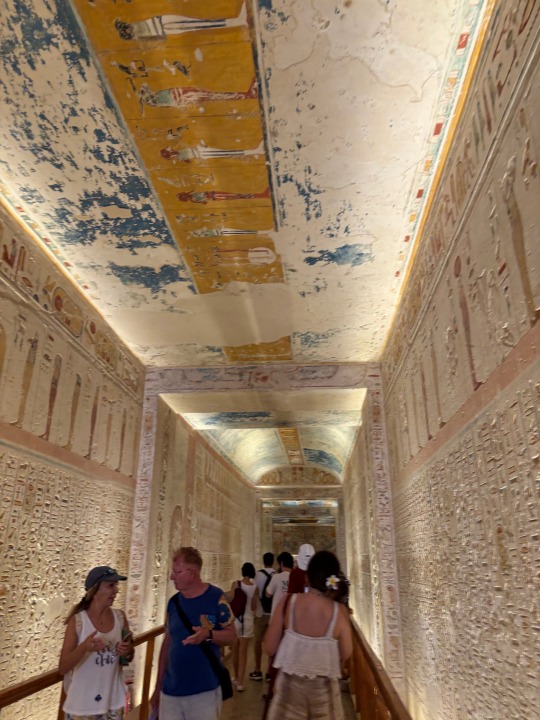
I just going to post pics for you to enjoy. The tunnel went on and on and on.

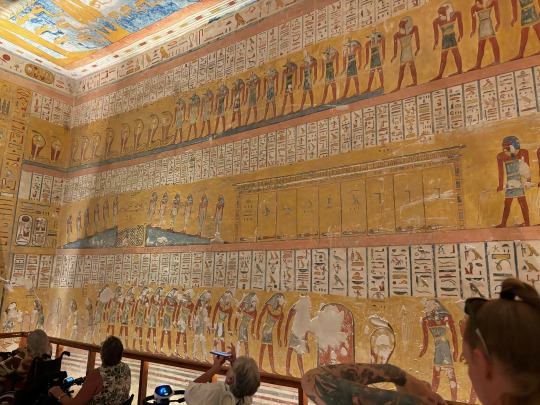
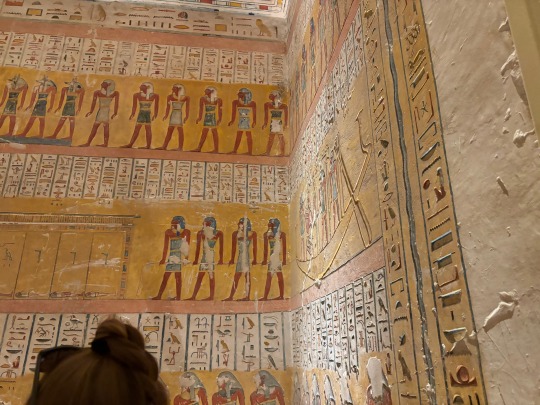

Until we reached the burial chamber.

Now the tombs saw many disturbing events. Your average tomb robber might be on the orders of the next Pharaoh who knew what was in there and thought some of the “stuff” might be better suited to his tomb. It might be someone looking for treasure - but the thing that is most disturbing was the tomb raiders who came to destroy. A great deal of time and energy was used to remove the faces of animals and humans. AND OMG - what if there was a bare breast. Take a look at this. We saw this over and over. The Christians had issues so they chiseled some things away, then the Muslims had issues, then who know had issues - ANYWAY they did a great job of screwing this up for posterity. It made me sad.
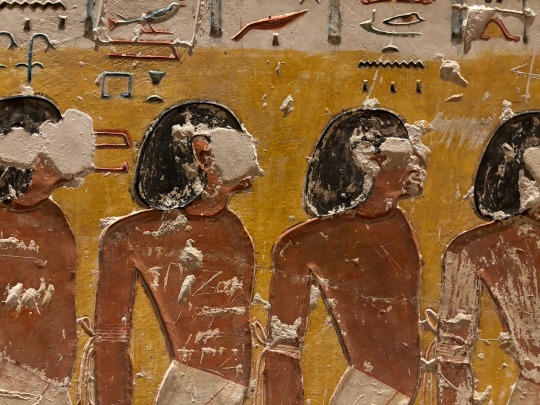
Next we walked to the tomb of Rameses III
Usermaatre Meryamun Ramesses III was the second Pharaoh of the Twentieth Dynasty in Ancient Egypt. Some scholars date his reign from 26 March 1186 to 15 April 1155 BC, and he is considered the last pharaoh of the New Kingdom to have wielded substantial power. You have to admit his tomb is pretty amazing and quite different than his son’s.

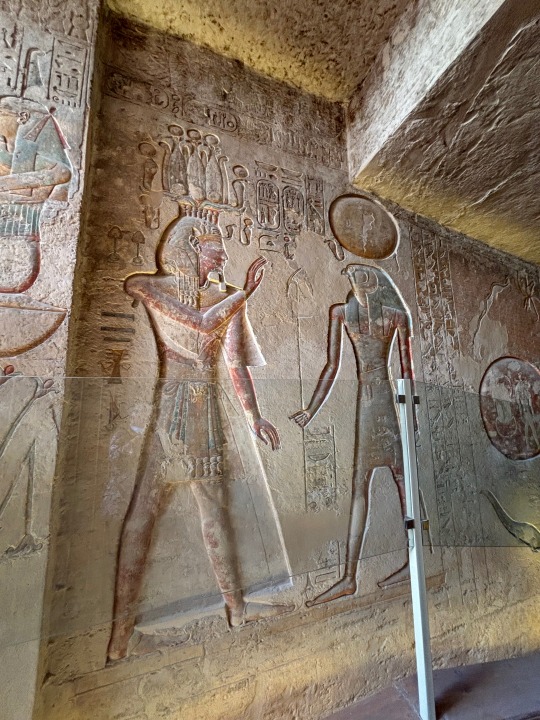


We were not able to enter the burial chamber - but there were little rooms to explore in here.
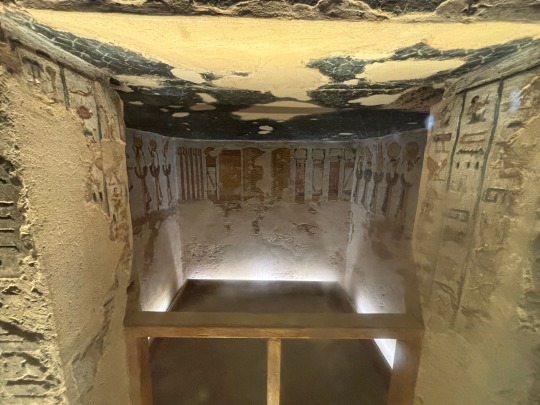
Next we visited the tomb of Rameses IX

Neferkare Setepenre Ramesses IX was the eighth pharaoh of the Twentieth Dynasty of Egypt. He was the third longest serving king of this Dynasty after Ramesses III and Ramesses XI. He died in 1111 BCE

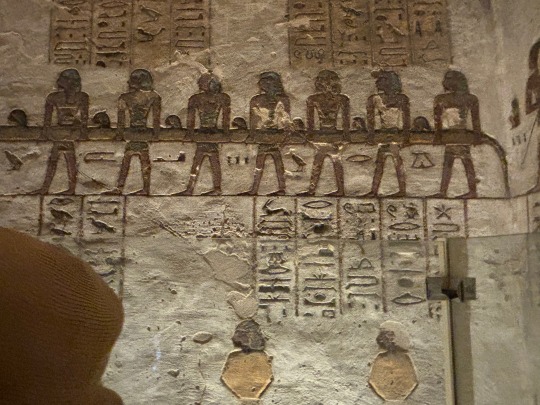

You can see why my mind was blown...
Finally we visited the tomb of King Tut.


So EVERYONE know that Howard Carter found the tomb of Tut and about the curse of King Tut’s tomb - but did you know this?
Nov. 4, 1922, Hussein Abdel Rasoul, water boy, moved sand so he could set down water jugs for Howard Carter's Team hunting Tutankhamun's tomb in the Valley of the Kings. He moved sand and found the 1st step of the staircase leading to Tutankhamun's tomb. He was rewarded with the gift he has around his neck in the photo.

King Tut is sometimes called the "boy king" because he ascended the throne at age 9 or 10, in the 14th century B.C. He died about a decade later. His treasure-filled tomb was discovered mostly intact, which is extraordinary given that most of the tombs in the Valley of the Kings had been looted in ancient times.
His tomb was found in a position that didn’t really fit the layout. It is believed that these tomb makers would start work on another took as quickly as they finished one - you know turning one out every 60 years or so. King Tut was just a teenager when he died and dit not reign long enough to have made any detailed plan for his tomb - so perhaps a ready made tomb was used. The former Pharaohs tombs were opposite each other while Tut’s was tucked under another tomb. Lucky for us.
Here is what we saw in this very small tomb….
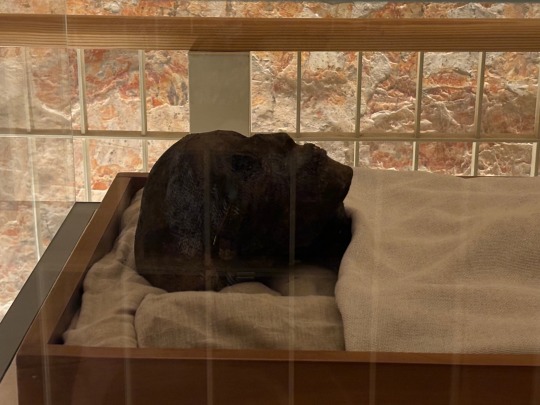
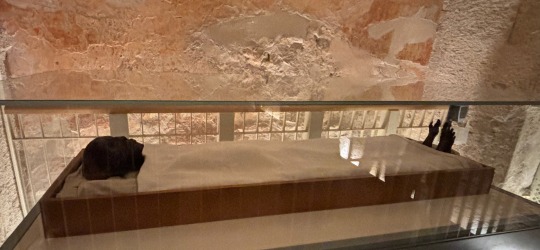
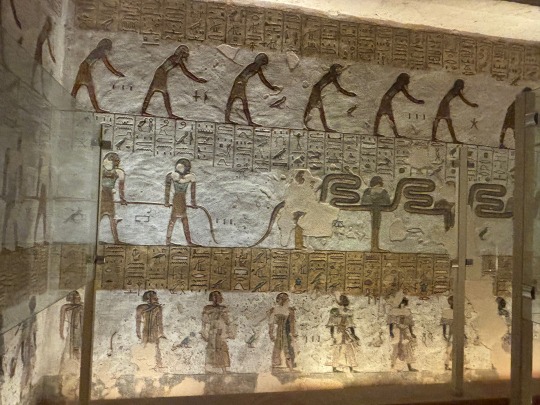
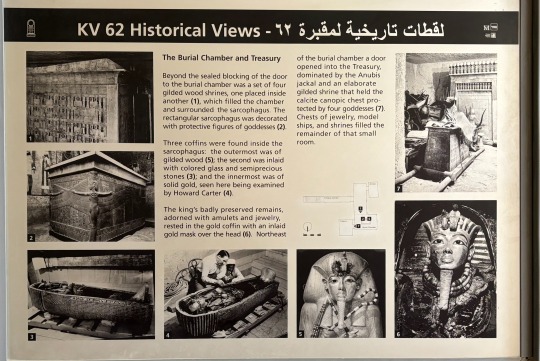
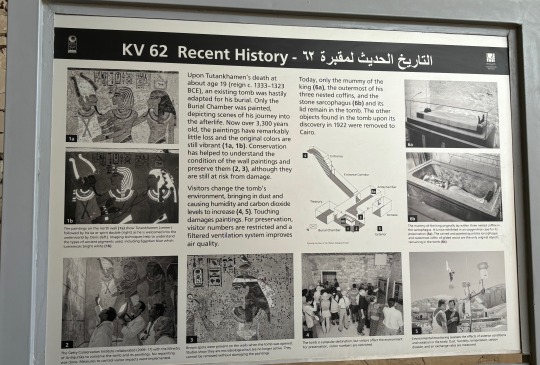
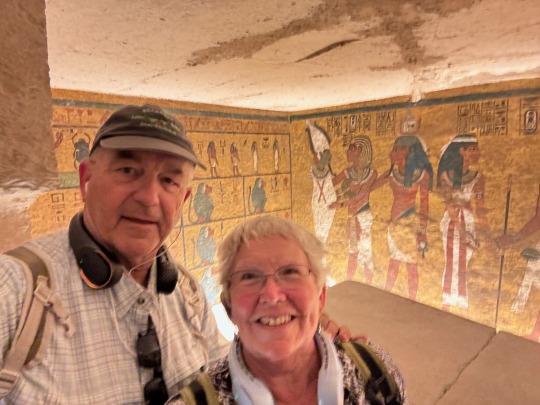
Look at the wall behind friends, Penny & John. AMAZING

And while this is rather irreverent I would like to end with Steve Martin’s SNL sketch
youtube
Because it is funny as hell!!!
We did this all in one morning and I have plenty to tell you about the afternoon. OMG EGYPT is amazing! Next up - the female pharaoh - Hatshepsut
Salem
0 notes
Text
0 notes
Text
Awe-Inspiring Temples and Tombs: Exploring Ancient Egypt
Did you know that the ancient Egyptians built their pyramids by measuring the earth's circumference? Did you know that the pharaohs were buried in underground tombs, often filled with gold, jewels, and other treasures?
The Egyptians built pyramids as significant monuments of their power. They believed that after death, they would become gods and live in these giant structures for all eternity.
Let’s explore your Luxury Egypt tours and these awe-inspiring temples and tombs on your next trip to Egypt!
Temple of Amenhotep III
The Temple of Amenhotep III is one of Egypt's most beautiful and awe-inspiring temples. Located in Luxor, this temple was built during the first half of the 14th century BC by Amenhotep III, son of Thutmose IV and Queen Mutemwia. The construction lasted 30 years and was completed under his successor Akhenaten (Amenhotep IV).
The temple faces east towards Karnak Temple, which houses significant deities such as Amun-Ra, Ra-Horakhty and Ptah, among others.

Temple of Seti I
Located in Abydos, Upper Egypt, the Temple of Seti I am dedicated to the god Osiris. It was built by Seti I and his son Ramesses II.
The main hall is decorated with scenes from different periods of Egyptian history. There are also many statues inside; some made of stone and others carved out of wood or ivory, depicting various gods and goddesses.
The Colossi of Memnon
The Colossi of Memnon are two massive statues (colossi) of Pharaoh Amenhotep III. The statues were originally made to represent the king as a seated figure, but later they were recarved to show him as a standing figure.
The statues depict King Amenhotep III in a striding stance with his hands resting on his hips and wearing the nemes headdress with uraeus, associated with kingship from early on in Egypt's history.
Karnak Temple Complex
Admire the Karnak Temple Complex when you are on tours Egypt as it is a vast collection of ancient temples and chapels, built by the pharaohs of the New Kingdom. The complex is located on the west bank of the River Nile in Thebes.
The Great Hypostyle Hall contains 134 columns that support its roof and walls.
The site also houses two colossal statues: one representing Amenhotep III and another depicting Ramses II.
Luxor Temple
Located in Luxor, Egypt, the Luxor Temple is one of the most popular tourist sites in Egypt. It was built during the reign of Amenhotep III (1417-1379 BCE) and was dedicated to Amon-Ra (also known as Amun). The temple was expanded by Ramses II (1279-1213 BCE) to include a pylon gate and two courts with hypostyle halls. Today, visitors can see these additions and many sculptures originally created for this site.
The Luxor Temple receives over 3 million visitors each year worldwide to see what remains after thousands of years!
Conclusion
The temples and tombs of Egypt are among the most awe-inspiring structures in the world. They represent a bygone era when people could build with unmatched skill, precision, and artistry. Their enduring beauty inspires us today as we marvel at these monuments from millennia ago. So, pack your bags for tours in Egypt and enjoy your next travel.
Source: Awe-Inspiring Temples and Tombs: Exploring Ancient Egypt
0 notes
Text
Tìm Hiểu Ý Nghĩa Tyldwick Tarot
Tyldwick Tarot từ lâu đã trở thành một trong những tựa bài Tarot được nhắc đến nhiều với sự kinh ngạc, mến mộ và sợ hãi! Bởi nó quá đẹp, quá độc đáo, quá lạ lẫm và quá thách thức đối với bất kì ai bước chân đến Tarot. Cho dù là người mới, hay người đã dùng Tarot lâu năm, cũng cần phải có một lượng kiến thức khổng lồ về hầu như mọi khía cạnh về biểu tượng, để có thể hoàn thành được việc tìm tòi tất cả các ý đồ tác giả truyền tải vào. Trên website tác giả bộ bài đã nói, mình xin dịch đại ý: “Không có hình ảnh nào đựa lựa chọn đưa vào lá bài mà không có ý nghĩa cả: các lá bài không phải là một tập hợp các hình ảnh cắt ghép ngẫu nhiên. Tác giả đã lấy cảm hứng từ kính vạn hoa, hình học, họa tiết kiến trúc, mật mã, và ngôn ngữ các loài hoa cũng như màu sắc.”
Và thật thách thức, vì bộ bài không hề đi kèm một ít tài liệu nào dù chỉ là một mảnh giấy ngắn gọn (như Wild Unknown Tarot chẳng hạn). Thật sự thách thức chưa? Nhưng hôm nay chúng mình đã sẵn sàng để vượt qua những thách thức này! Hãy cùng chúng mình tìm hiểu về các biểu tượng này nhé, mọi thứ sẽ nhẹ nhàng và không kém phần thú vị đâu 😉
O. The Fool
– Chiếc gương với những đường nét trang trí đầy nghệ thuật.
– Chiếc mặt nạ Sunman với nụ cười mê hoặc.
– Bức tượng chú chó GreyHound đang quay vào gương.
– Một hình Mộc Nhân đang đứng yên.
– Máy đánh nhịp Metromone đang được đậy lại.
– Những con Bươm bướm.
II. The High Priestess
1. Bức tượng Nữ hoàng Isis ( hoặc Iset không phải tượng nữ thần Isis nhaBiểu tượng cảm xúc colonthree ) nữ hoàng vợ vua Thutmose II và mẹ của vua Thutmose III, bà được xem là mẹ của các vì vua ( King’s Mother ) khi con trai bà đang làm Pharaoh và sau này được xem làm vợ của các vị thần ( God’s Wife ), hình ảnh của bà trên lăng mộ của Thutmose III được ví như nữ thần Isis.
2. Một cái đồng hồ trang trí điêu khắc phong cách Ai Cập. nếu để ý ta có thể thấy phía trên đồng hồ so với bản gốc thì đã mất đi con nhân sư – biểu tượng canh giữ lối vào những ngôi mộ, sự hung dữ, bạo tàng, tự cao chỉ bị khuất phục bởi trí thông minh. Hai bên là cột obelisk Ai Cập thường được đặt trước cổng vào của các ngôi đền.
III. The Empress
Nữ thần Artemis (Diane) của Thần Thoại Hy Lạp.
Bức tượng này được mô phỏng lại bên trong Đền Artemis nằm ở Thổ Nhĩ Kì, đã bị hư hoại chỉ còn lại nền móng, đây là một trong 7 kỳ quan của thế giới cổ đại. Người Hy Lạp xưa không chỉ thờ phụng nữ thần Artemis như vị thần săn bắn hoặc một thần bảo hộ cho nghề săn bắn. Kể từ nguồn gốc xa xưa thì Artemis là nữ thần bảo hộ cho muông thú trong rừng rồi sau mới chuyển thành nữ thần săn bắn tiếp chuyển thành nữ thần của cây cỏ hoa lá. Từ đó, Artemis được coi là nữ thần của sự phì nhiêu, cây sai quả, lúa sinh nở, cho hạnh phúc gia đình, trẻ sơ sinh. Rồi lại kiêm luôn cả chức năng nữ thần Mặt Trăng, nữ thần phù thủy, ma quái Hecate. Vì thế bức tượng này là hình ảnh một vị nữ thần với nhiều bầu vú cùng trâu bò xung quanh khắp cơ thể mang đến sự sinh sôi nảy nở cho muôn loài.
IV. The Emperor
Marcus Aurelius Antoninus Augustus, được biết trong tiếng Pháp là Marc-Aurèle (Ngày 26 tháng 4 năm 121 – 17 tháng 3 năm 180) là một Hoàng đế La Mã, trị quốc từ năm 161 đến khi ông mất vào năm 180. Ông từ là Tổng tài của đế quốc La Mã vào năm 140. Kể từ thiếu thời, ông đã được học kỹ về triết học, và sau này, ông được vị minh quân Antoninus Pius chọn làm con nuôi để thừa kế ngai vàng. Sau khi Antoninus Pius qua đời, ông là đồng Hoàng đế của Lucius Verus từ năm 161 cho đến khi Hoàng đế Lucius mất năm 169. Về cuối đời, ông đồng trị vì với Hoàng đế Commodus – con trai của ông, cho đến khi ông tạ thế. Ông là vị Hoàng đế thứ 16 của Đế quốc La Mã (nếu tính luôn cả bốn ông vua trị vì ngắn ngủi trong Năm Tứ đế), là vị Hoàng đế cuối cùng trong thời đại Ngũ hiền đế, và cũng được xem là một trong những nhà hiền triết kiệt xuất của trường phái Khắc Kỷ.
Hai cục hai bên một cái là địa cầu tượng trưng cho địa lý, một cái là hỗn thiên nghi, tượng trưng cho vũ trụ. Lá này là “Thông thiên văn, tường địa lý”
V. The Pope
Đức Giáo Hoàng Boniface VIII, vị giáo hoàng đấu tranh cho chế độ Giáo Hoàng bị áp bức bởi Hoàng Gia Pháp, được khởi xướng bởi vua Philippe IV le Bel.
VI. The Lovers
– Bức tượng 1: Thần Hermes trích từ tượng “Hermes and the infant Dionysus” của Praxiteles. Tượng mô tả giai đoạn khi thần Hermes đang cố gắng giúp đỡ thần Zeus che giấu đi kết quả của mối tình vụng trộm với nàng Semele là đứa bé Dionysus, vị thần rượu nho.
– Bức tượng 2 (phần nền phía sau): Nhìn qua tưởng rằng đây là bức tượng về Diana hay Artemis, nữ thần của mặt trăng, săn bắn, nữ thần tượng trưng cho sự Trong Trắng, giữ gìn trinh tiết.
Nhưng thật ra bức tượng này cũng là dành cho một người tên là Diana nhưng mà là Diane de Poitiers một ái phi được sủng ái nhất của vua Henry II, được đặt trên đài phun nước của lâu đài d’ANet ( nay đã được đem về bảo tàng Louvre – Pháp ). Bức tượng ví bà có nét đẹp trong trắng tựa như nữ thần Diana. Vẻ đẹp trẻ trung của bà được gìn giữ theo thời gian cho đến khi bà mất – 66 tuổi. Và người ta khám phá ra được nguyên nhân cái chết của bà là do vì quá yêu mà mong muốn gìn giữ sắc đẹp của mình một cách mù quáng, chết vì mong muốn tìm kiếm một vẻ đẹp vĩnh hằng, bà đã bị ngộ độc do uống vàng ( một trong những cách làm đẹp của các nữ quý tộc châu âu ngày xưa ). Vì quá yêu, muốn được sự quan tâm của nhà vua, muốn vượt lên hơn các ái phi khác và đã trở thành ái phi được vua Henry II sủng ái nhất ( mặc dù hơn nhà vua 20 tuổi) nên đã mù quáng mà hại đến chính mình.
VII. The Chariot
– Lá bài này hầu như là dành để cho vị thần Apollo, từ bức tượng The “Ephebe of Agrigento” được xem là tượng trưng cho thần Apollo và cũng là cho các chàng thanh niên trẻ của Hy Lạp cổ đại ( 17 – 20 ) bị bắt đi đào tạo quân sự khắc nghiệt và làm mọi cách, mọi thủ đoạn để đấu tranh sinh tồn, sau khi kết thúc đào tạo các chàng trai này sẽ được xã hội công nhận là một người đàn ông trưởng thành đủ sức để bảo vệ những gì mà họ yêu quý. Hình ảnh điêu khắc hai con nhân sư “Naxian Sphinx” cũng là bức tượng nhân sư đặt tại đền thờ nơi được cho là khi thần Apollo giết quái vật Python vì đã cố hãm hiếp mẹ của ông là bà Leto khi đang mang thai Apollo với Artemis và chịu sự trừng phạt vì Python là con của Gaia.
– Đằng sau là bức tranh miêu tả cuộc đi săn heo rừng và săn gấu có tên là “The Boar and Bear Hunt tapestry”.
IX. The Hermit
Bức tượng “Dying Seneca”.
Lucius Annaeus Seneca (thường được gọi đơn giản là Seneca hay Seneca Trẻ (4 TCN-65) là một triết gia người La Mã thuộc trường phái triết học khắc kỷ và là chính khách, nhà biên kịch, nghệ sĩ hài đượng thời, ông là một tên tuổi lớn của văn học La Mã. Ông từng là thầy giáo và cố vấn cho hoàng đế Nero Bạo chúa. Ông sau đó đã bị ép buộc phải tự tử vì bị cho là đồng lõa trong âm mưu ám sát hoàng đế Julio-Claudian, tuy nhiên, ông có thể đã được tuyên vô tội. Cha của ông là Seneca Già và anh trai là Gallio.
“Timendi causa est nescire –
Ignorance is the cause of fear.”- Seneca –
“Vô minh là ngọn nguồn của nỗi sợ hãi”
XVI. The Tower
– Sự sụp đổ và những chiếc mặt nạ. Từ trên xuống dưới từ trái qua phải:
Từ trên xuống dưới từ trái qua phải:
1. Mặt nạ Ko Omote trong kịch Noh Nhật Bản.
2. Mặt nạ Xiuhtecuhtli – thần lửa của văn minh Aztec.
3. Có thể là mặt nạ kinh kịch Trung Quốc – màu xanh lá cây
4. Mặt nạ truyền thống của người Bulaba ở Châu Phi.
5. Mặt nạ thần rượu nho của Hy Lạp.
6. Mặt nạ thần Mặt Trời của văn minh Inca.
– Tháp Babel (Tháp Babilon tại vườn treo Babilon- một trong 7 kỳ quan thế giới cổ đại). Đã bị hư hỏng toàn bộ chỉ còn nền móng, hình ảnh này là được mô phỏng lại theo mô tả của các văn bản Hy Lạp.
Tháp Babel , trong Sách sáng thế, là một ngọn tháp to lớn được xây dựng ở thành phố Babylond. Theo kinh thánh, một nhóm người là các thế hệ tiếp theo sau Đại hồng thủy, nói cùng một thứ ngôn ngữ và di trú từ phía đông, đã tham gia vào việc xây dựng. Những con người đó quyết định rằng thành phố của họ nên có một cái tháp thật to lớn đến mức “đỉnh của nó chạm đến thiên đường.”
Tuy nhiên, Tháp Babel không được xây dựng để thờ phượng Đức Chúa Trời, nhưng là để thể hiện sự huy hoàng của con người, để “đặt tên” cho người xây tháp,: “Sau đó họ nói, ‘Đến đây, chúng ta xây dựng một thành phố của riêng chúng ta, và một ngọn tháp với đỉnh của nó chạm tới thiên đường, và chúng ta hãy đặt tên cho chính chúng ta; nếu không, chúng ta sẽ phân tán khắp nơi trên mặt đất.'” (Genesis 11:4). “5 Đức Giê-hô-va bèn ngự xuống đặng xem cái thành và tháp của con cái loài người xây nên. 6 Đức Giê-hô-va phán rằng: Nầy, chỉ có một thứ dân, cùng đồng một thứ tiếng; và kia kìa công việc chúng nó đương khởi làm; bây giờ chẳng còn chi ngăn chúng nó làm các điều đã quyết định được. 7 Thôi! chúng ta hãy xuống, làm lộn xộn tiếng nói của chúng nó, cho họ nghe không được tiếng nói của người nầy với người kia. 8 Rồi, từ đó Đức Giê-hô-va làm cho loài người tản ra khắp trên mặt đất, và họ thôi công việc xây cất thành. 9 Bởi cớ đó đặt tên thành là Ba-bên,(i) vì nơi đó Đức Giê-hô-va làm lộn xộn tiếng nói của cả thế gian, và từ đây Ngài làm cho loài người tản ra khắp trên mặt đất.” (Kinh Thánh, Sáng Thế Ký 11:9).
XIX. The Sun
1. Surya (Devanagari: सूर्य, sūrya) là vị thần chính, thần Mặt Trời, một trong ba ngôi tối linh (Adityas), con trai của Kasyapa và vợ của ông là Aditi, hay là con của Indra, hay của Dyaus Pitar (tùy theo phiên bản). Ông có mái tóc và cánh tay bằng vàng ròng. Cỗ xe ngựa của ông được kéo bởi bảy con ngựa, tượng trưng cho bảy Luân xa. Ông là “Ravi” hay là người cai quản ngày Chủ Nhật (“ravi-var”).
Trong các văn bản Hinđu Giáo, Surya được cung kính miêu tả như một hiện thân hữu hình của ông Trời mà mọi người có thể nhìn thấy hàng ngày. Hơn nữa, Shaivites và Vaishnavas thường đề cập đến Surya như là một hiện thân của Shiva và Vishnu. Ví dụ như, mặt trời được Vaishnavas gọi là Surya Narayana. Trong thần thoại Shaivite, Surya được xem là một trong tám dạng của thần Shiva, tên là Astamurti.
Ông được xem là năng lượng thanh lọc (Sattva Guna) và biểu trưng cho tâm hồn, Vua, những người cao quý và người cha.
>>> Xem thêm: XEM BÀI TAROT – TÌM CÂU TRẢ LỜI CHO VẤN ĐỀ BẠN ĐANG VƯỚNG PHẢI!
2. Hoa văn phía sau bức tường được tìm thấy trên các bức thảm Ba Tư.
XXI. The World
– Shiva (si-va), (tiếng Phạn: शिव) Śiva, phiên âm Hán Việt là Thấp Bà, là một vị thần quan trọng của Ấn Độ giáo, và một khía cạnh của Trimurti. Phái Shaiva của Ấn Độ giáo (một trong ba giáo phái có ảnh hưởng nhất trong Ấn Độ giáo đương đại) xem Shiva là vị Thượng đế tối cao. Trong phái Smarta, Shiva là một trong năm hình thức nguyên sơ của Thượng đế. Trong một số trường phái Ấn Độ giáo khác, Brahma, Vishnu, và Shiva đại diện cho ba khía cạnh thần thánh của Ấn Độ giáo và hợp chung thành bộ tam thầnTrimurti, với Brahma là người sáng tạo, và Vishnu là đấng bảo hộ và Shiva là hiện thân của sự hủy diệt. Nhưng bên ngoài bộ tam thần này, Shiva là hiện thân của tất cả: sáng tạo và một sự khởi đầu mới cũng như bảo quản và tiêu hủy. Thần Shiva còn được gọi bằng rất nhiều tên và hình thức khác. Phổ biến hơn cả là hình thức Nataraja (Vua khiêu vũ). Đây là hình thức biểu trưng cho quyền năng tuyệt đối và là biểu hiện hoàn hảo nhất về Thần Shiva. Nataraja có nguồn gốc từ chữ Phạn: “Natya” là khiêu vũ và “Raja” là vua. Theo Ấn Độ giáo, ở cuối mỗi chu kỳ vũ trụ, Thần Shiva là Nataraja sẽ thực hiện các vũ điệu thần thánh của mình để hủy diệt vũ trụ cũ không còn sức sống, chuẩn bị cho quá trình sáng tạo ra vũ trụ mới. Hai hình thức phổ biến của khiêu vũ Nataraja là Tandava – điệu nhảy dữ dội, bạo lực kết hợp với hủy diệt và Laysya – khiêu vũ nhẹ nhàng, gắn với tái sinh, sáng tạo. Laysya được thực hiện sau Tandava, với sự đáp ứng của người phối ngẫu là Nữ thần Parvati. Thực chất, Tandava và Laysya là hai mặt của bản chất của Shiva, phá hủy để tái sinh, sáng tạo.
Trong điêu khắc Ấn Độ, hình tượng Shiva Nataraja thường được làm bằng đồng, dưới hình thức tượng tròn, cách thể hiện tương đối thống nhất. Thần Shiva đang thực hiện vũ điệu Tandava trong vòng lửa, biểu hiện của vũ trụ. Chân phải đạp lên con quỷ lùn Apasmara, tượng trưng cho chiến thắng của Shiva trước sự lầm lạc, mê muội, thiếu hiểu biết. Chân trái nâng cao và đá sang phải để giữ trạng thái cân bằng. Thần có 4 tay, tay phải phía sau cầm cái trống Damaru hình chiếc đồng hồ cát, tượng trưng cho âm thanh khởi nguyên sáng tạo thế giới, nhịp đập của trống là nhịp đập của vũ trụ. Tay trái phía sau nắm ngọn lửa, tượng trưng cho sức mạnh hủy diệt. Tay phải phía trước bắt ấn Abhaya, thể hiện sự không sợ hãi. Tay trái phía trước đưa sang phải và hướng xuống phía chân trái với lòng bàn tay mở rộng là biểu hiện của giải thoát, giác ngộ. Sức mạnh năng lượng khi thực hiện điệu múa khiến mái tóc của Thần bay tung sang hai bên… Tổng thể cho thấy, Tandava là vũ điệu vận hành vũ trụ của Thần Shiva, khởi nguồn cho một chu kỳ mới Sáng tạo – Bảo tồn – Hủy diệt.
– Các cánh hoa trên vòng nguyệt quế xung quanh tượng Shiva là dogwood (Sơn thù du). Theo ý nghĩa huyền thoại của hoa thì Dogwood là cây đã được lựa chọn để cung cấp gỗ cho sự đóng đinh của Chúa Giêsu Kitô. Tuy nhiên, các cây không hài lòng về hành động độc ác này đã buộc phải làm, và do đó Chúa Giêsu sau khi bị đóng đinh vào nó, nói với nó điều này: “Bởi vì hối hận và tiếc cho sự chịu đựng của tôi, cây Dogwood sẽ không bao giờ phát triển đủ lớn nữa để sử dụng như một cây thánh giá. Từ nay trở đi Dogwood sẽ thanh mảnh, cong và xoắn, và hoa của Dogwood được thực hiện dưới hình thức chuyển ngang, hai dài và hai cánh ngắn. Ở trung tâm của các cạnh ngoài của mỗi cánh hoa sẽ có bản in móng tay, màu nâu với rỉ sét và màu đỏ, và ở giữa của hoa sẽ là một vòng gai, và tất cả những ai nhìn thấy cây và hoa sẽ nhớ … “
– Về các khối hình học thì trong kiến trúc 3 hình này gồm hình vuông, hình tròn, hình tam giác đều là 3 hình học đặc biệt vì tính hoàn hảo của nó. Về các ý nghĩa tượng trưng thì như ta đã biết hình vuông tượng trưng cho đất – cơ thể vật lý. Hình tròn tượng trưng cho trời – ý thức cao cấp, ý thức vũ trụ. Hình tam giác thì trong đạo phật tượng trưng cho tam giới, sự luân hồi hay tam bảo: quá khứ – hiện tại – tương lai, trong hinđu giáo thì là tượng trưng cho 3 vị thần tối cao, ngoài ra còn tượng trưng cho cảm xúc và tinh thần.
Nguồn: https://tarot.vn/tyldwick-tarot-chuyen-du-hanh-kham-pha-y-nghia-bieu-tuong/
0 notes
Text
The Second Coming of the Pharoah of Pyramid 33 (224/240 feet tall) in the Giza.
Thutmose IV (sometimes read as Thutmosis or Tuthmosis IV, Thothmes in older history works in Latinized Greek; Ancient Egyptian: ḏḥwti.msi(.w) "Thoth is born")[3] was the 8th Pharaoh of the 18th Dynasty of Egypt, who ruled in approximately the 14th century BC. His prenomen or royal name, Menkheperure, means "Established in forms is Re."[4] He was the son of Amenhotep II and Tiaa.
0 notes
Text
The Writing of History in Ancient Egypt (I)
Roberto B. Gozzoli The Writing of History in Ancient Egypt during the First Millennium BC (ca. 1070-180 BC). Trends and Perspectives, Golden House Publications, 2006, GHP Egyptology 5 (excerpts from the Introduction)
“As remarked by various Egyptologists and Near Eastern historians, history writing in a “Western form” as re-thinking and re-elaboration of events and what can be learnt from them is one the major absentees in ancient Egypt.3 If a rapid survey of Egyptian historical documents is done using considered the initial definition of primary sources and history writing as given by Bengtson and Van Seters as parameter, the statements made by Bull in 1955 and Redford in 1986 about the complete inexistence of Egyptian historical writing can be understood, as none of the Egyptian “historical” texts can stand.4 An “objective” history on Herodotus’ or Thucydides’ steps was never an aim in ancient Egypt.5 In spite of that, “that the Egyptians developed no distinct historiographical genres should not be taken to mean that the ancient community along the Nile had no regard for, nor consciousness of, its past. It had, in fact, a strong sense of its own past, if not a developed idea of history”.6 In effect, ancient Egyptians recollected royal deeds and events of the past in four major groupings:
1) Royal material officially promulgated by king’s initiative: stelae in Egypt or foreign land and temple wall inscriptions and reliefs narrating military enterprises or quarry expeditions, cultic royal lists with the actual pharaoh worshipping venerated ancestors, letters to foreign kings.
2) Documentary royal lists;
3) Private biographies;
4) Histories.7
In Egyptian royal texts such as triumphal reliefs and military stelae, the enemy is always depicted as rebellious, while the pharaoh is the one who wins whenever he comes to the battlefield.8 This feature has been generically called as propaganda.9 The term is usually interpreted in its negative aspects, as full of bombastic expressions celebrating the king and his deeds.10 But for an ancient Egyptian, any event was strictly bound to the concept of ritual: a king’s victory against his enemies is represented as defeating the Nine Bows – his cosmic enemies.11 Therefore, whether he had effectively won the Nine Bows or not becomes entirely irrelevant, as the pharaoh’s victories permitted the maintenance of the order of the world, represented by Maat, which the supreme god had predestined to his people.12 Furthermore, any narrated happening stands on a double plan in the Egyptian mental horizon. The first is linear: any royal deed follows an earlier one in a chronological scale. The second plan is instead cyclical: as the Nile inundation happens every year, any sequence of events will return again in the future.13 At this point, any royal victory becomes the re-enactment of a primordial victory made by some ancestors.14
For this reason, the Egyptian royal texts continuously repeat phrases such as: “the similar was found in the book of the ancestors”. Any action had to lead to the“first time”, to the primordial phase of the humankind, when the god inspired the humans.15 This adherence to earlier models commits the texts themselves to a homologation of clauses and topics, which are almost immutable from an inscription to the other.16 Moreover, any pharaoh claims to have surpassed what his ancestors had already done, and any temporal dynamicity is completely absorbed.17
As any pharaoh was keen to stress, no victory was possible without god’s help. For this reason royal texts conclude with the reward given to the deity, whose earthly arm is embodied by the pharaoh. For instance, the campaigns of Thutmose III in Syria/Palestine are known from the Annals the king carved on the side wall of the northern ambulatory around the barque shrine.18 In the initial part of the Annals (Urk. IV, 648 2-7), Thutmose III justifies his intervention as compelled by the restoration of the order: “For it had been a period of [many] years [that Retenu has lapsed into] brigandage, while everyone was committing theft against his fellow,and […]. Then it transpired, in later times that the garrison which was there was (now) in the town of Sharuhen, while (the territory) from Yarusa as far as the distant marshlands had broken out in rebellion against His Majesty”. The pharaoh at this point justifies his actions in Asia using the theme of the enemy as rebel to the pharaoh’s power, which by the time the Annals were carved had become a literary topic.19 Furthermore, the ideological base of the inscription is the same as it has been already enunciated above: as violence spreads in the country, forces the pharaoh to intervene in order to restore Maat.
This initial statement made by Thutmose III serves to introduce the long series of victorious campaigns from the twenty-second until the forty-second year, campaigns rewarded by the various tributes the Levantine kings give to thepharaoh.20 Recent and not so recent studies have demonstrated that inw should be considered in some cases as exchange between kings of the equal status, and not just from the subdued kings to the victorious one.21 For the existence of gift exchange between pharaoh and foreign kings, the later cuneiform tablets from Amarna are the best example. In them, the Mesopotamian kings are not afraid to condemn pharaohs’ avarice.22 Most importantly, Amenhotep III, Akhenaten and Tutankhamun are Assyrian and Babylonian kings’ brothers.23 Therefore, the equalitarian level, which is completely denied by the Egyptian pharaoh in his own texts, is with energy reasserted by his foreign counterpart.
In the specific case of Thutmose III’s received gifts, the pharaoh is not the final addressee of them: the placement of his annals inside god’s temple very close to the sancta sanctorum declares that the king can obtain these gifts only thanks to god’s predilection.24 The king is the favoured; therefore god makes happen anything asked by the king himself. But the god needs his rewards too, and the inw passing though pharaoh’s hands are used to embellish god’s house. Moreover, the proximity of the Annals to the divine barge where the god rests -a part completely inaccessible to the public view- serves to recall the existence of the dialogue between god and king, which is completely private.25 If this instance may not be considered as sufficient, I would like to consider a further example, the battle of Kadesh between Ramesses II and Muwatalli.26 The pharaoh made a great effort to celebrate the fact that he alone defeated the hordes of Hittite chariots attacking the Egyptian camp, a statement recorded in various places of Egypt (Abydos, Karnak, Abu Simbel, and the Ramesseum) as well as on papyri.27 As this Egyptian “victory” is confronted with the cuneiform versions of the event issued by the Hittite king, it emerges that Ramesses II asserted victory when probably was nothing more than a draw.28 Considering Ramesses II as pretentious and magniloquent in his statement of victory over Muwatalli may be correct if confronted with the historical reality. But in the heat of the battle, as Ramesses II calls the god to his help; the pharaoh is the legitimate son who has done benefactions to his divine father.29 Having listened to his son, the god cannot ensure anything less than victory. Therefore, the pharaoh has to become the winner at Kadesh; his defeat would be an offence against the deity.30″
On line source with the entirety of the thesis https://href.li/?https://www.academia.edu/359798/The_Writing_of_History_in_Ancient_Egypt_during_the_First_Millennium_BC_ca_1070_180_BC_Trends_and_Perspectives
1 note
·
View note
Text
All inclusive Easter Tours
You can be sure you don't miss anything by using this All Inclusive Easter Tours of well-known sites and tourist attractions in Egypt, the home of the pharaohs and one of the most significant ancient civilizations in history.
Even though we are aware that there are countless things you can do, we can assure you that seeing the Egyptian Pyramids and the Sphinx up close, visiting the magnificent Abu Simbel Temple, cruising the Nile, looking for Tutankhamun's Tomb in the Valley of the Kings, crossing the desert, or getting lost in Cairo's Kalili Bazaar are just a few of the experiences that will remain in your memory and serve as one-of-a-kind gifts, you can enjoy Them during your All Inclusive Easter Tours.
- One of the most stunning tourist destinations in Egypt and the entire globe is the Pyramids of Giza, the only one of the Seven Wonders of the Ancient World to have survived, so you can visit Giza Pyramids during Easter Egypt Tours and enjoy the extraordinary Giza Pyramids.
The three enormous pyramids, fewer than 20 kilometers from Cairo and including the tombs of the pharaohs Cheops, Chephren, and Mykerinos, stand out from the rest of Egypt's structures.
Giant limestone blocks were used to build white stone pyramids on the exterior of the building, which the pharaohs thought would grant them immortality. This was done approximately 2500 BC.
The ever-watchful Sphinx, standing more than 20 meters tall next to Egypt's Pyramids, is one of the nation's icons along with the pyramids.
We advise visiting them as early in the day as possible (they open at 8 am) in order to secure one of the few tickets for the inside of the Pyramid of Cheops or Chephren, which is not advised to enter if you have claustrophobia, in addition to avoiding the organized groups.
- There is a location called Abu Simbel in Nubia, in southern Egypt, that surpasses the beauty of the Egyptian Pyramids.
This archaeological site is notable for the two rock-cut temples that the great Pharaoh Ramses II had built in the thirteenth century BC to celebrate a military victory. Both temples were built in honor of the pharaoh and his favorite wife, Nefertari, and have a fascinating backstory that made them even more famous to the world when they had to be relocated in 1968 due to the building of a dam on the Nile River, so enjoy All Inclusive Egypt Easter Tours with Maestro Egypt Tours
Like the Pyramids, we advise visiting early in the day to avoid the hottest and busiest times and staying nearby for one night to take in the nighttime light show.
You can do this tour from Cairo to Abu Simbel in one day by the airline, or you can take a bus or a car and join the convoys as they depart from Aswan, where you will arrive after a 3-hour drive.
- One of Egypt's most stunning landmarks and tourist attractions, the Valley of the Kings, is located on the west bank of the Nile, 10 kilometers from Luxor.
This valley, which is made up of two valleys, the East and West or Valley of the Queens, where more than 60 tombs have been discovered, became the cemetery for most of the pharaohs, as well as queens and princes of the reign of the New Empire.
You can see three tombs if you purchase a ticket to the Valley of the Kings. Given that the tomb of Tutankhamun is not included and must be purchased separately, we advise seeing the tombs of Thutmose III, Setos I, Ramses IV, VI, and IX, Tausert, and Setnakt.
The Valley of the Kings is accessible by cab from Luxor and opens at 6 am. Booking this tour with Maestro Egypt Tours, on which you will also see the Temple of Hatshepsut and the Colossi of Memnon in addition to the Valley of the Kings, is a more comfortable option.
Egypt Easter Tours All Inclusive:-
1- Cairo Tours in Easter
2- Cairo Tour Package in Easter
3- Cairo and Nile Cruise Tours in Easter
4- Easter Travel Package to Egypt
For more info. kindly visit www.maestroegypttours.com
or send your request to [email protected]
Tel : +201001422529
#Egypt Easter Tours#Egypt Easter Packages#Easter in Egypt#egypt easter holidays#egyptian easter#Easter Egypt 2023#Easter Nile Cruise Tours#Cairo Tours in Easter
0 notes